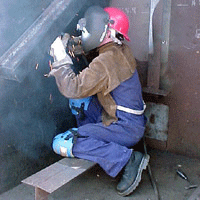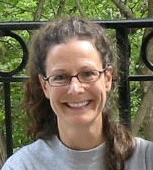Worker Safety
Air Date: Week of August 1, 2008

The Department of Labor’s proposal could double welders' legal exposures to hazardous chemicals. (Courtesy of the Department of Labor Occupational Safety and Health Administration)
Celeste Monforton of the George Washington University School of Public Health was perusing the Department of Labor website when she found some fine print. The Department was proposing allowing worker exposure to higher levels of chemicals, though for shorter periods of time. She published what she discovered in her blog and shares it with host Bruce Gellerman.
Transcript
GELLERMAN: Celeste Monforton scrupulously scans obscure White House websites. Early in July Monforton was digging deep into the administration’s site for The Office of Information and Regulatory Affairs and there she found a nine-word sentence written in federal bureaucratese – that could fundamentally change the way the government determines workplace safety. Monforton, a lecturer and research associate at the George Washington University’s School of Public Health wrote about the Administration’s sweeping proposal that she found buried in a website on her blog: The pump handle.
MONTFORTON: This proposal is addressing the process by which the two main agencies in the Department of Labor, OSHA and MSHA (the Mine Safety Agency), regulate occupational health hazards.
GELLERMAN: And OSHA is the Occupational Safety and Health Administration.
MONTFORTON: Correct. It mandates an unnecessary step at the front end of that process which will, in my estimation, delay protections by at least two or three years. And when you think about worker safety and health, two or three years is two or three years of additional exposure to those chemical contaminants day in and day out.
GELLERMAN: Well as I understand it, the existing regulations assume that workers are going to be at the same job for 45 years and the proposal here is to change that.

Celeste Monforton is a Lecturer and Research Associate at the George Washinton University’s School of Public Health and Health Services. (Courtesy of Celeste Monforton)
GELLERMAN: So what is the proposal that the Department of Labor is proposing?
MONTFORTON: The Department of Labor is proposing that the assumption that people work 45 years is flawed and that it should be based on the average number of years that people work in a particular industry. They believe that on average most people don’t work 45 years so if you’re going to develop a new standard on chemical X, you don’t need to set a protective level that’s based on someone that might work there 45 years you should only set it based on that they’re going to work there on average 10 years.
GELLERMAN: Well but they have a point there, right? People don’t ordinarily work in jobs, the same job, for 45 years?
MONTFORTON: Well, I think that it’s correct that on average people don’t work in a particular job for 45 years. But we know that these standards are meant to be protective and that we know individuals who do work in jobs for more than 30 years. I just was speaking with a woman who’s a housekeeper, a hotel housekeeper; she’s worked for 46 years. So her exposures definitely wouldn’t be covered if there was a standard put in place and someone wanted to say, “Well let’s just protect for the average.” That’s not what public health is about. It’s not about just protecting the average individual, it’s protecting the whole population of individuals, even those that have exposures for 45 years. And we know that in particular types of occupations—if you’re a tradesman that is a welder, or a plumber, or an electrician—you probably do that job for 45 years, it’s not something that you just do for a couple of years and then you take up a new career.
GELLERMAN: So this proposal by the Department of Labor which you caught on this obscure website is a little bit unusual in terms of the way it’s made public?
MONTFORTON: Absolutely. The thing that’s really, for me, that very nefarious about this whole process is the two agencies that have the most experience and actually do risk assessment as part of their responsibilities were not involved in developing this proposal. They actually contracted it out and paid 347,000 dollars to individuals to work on this. So it was, you know they excluded people within the agency who have the most experience doing this.
GELLERMAN: Didn’t the National Academy of Sciences look at this specific issue back a few years ago?
MONTFORTON: Absolutely. This is something that when I saw it on the website, it really piqued my interest, because in 2006, the White House attempted to put in place comprehensive guidelines for risk assessment that would have gone across the board for all agencies. And when that was released, the scientific community and public health advocates and environmental health proponents looked at that and saw how damaging it would be for public health and environmental health.

The Department of Labor’s proposal could double welders' legal exposures to occupational hazards.(Courtesy of the Department of Labor Occupational Safety and Health Administration)
GELLERMAN: I have to ask you Ms. Monforton, what are you doing looking at this obscure website?
[MONTFORTON LAUGHS]
MONTFORTON: I’ll try to answer that question. As public health researchers here in Washington, D.C., we look at, part of our responsibility to show the rest of the country what’s going on here in Washington with respect to worker safety and health, and so we just make it our practice of checking out those websites, and finding out what is in the pipeline and over the course of this administration much of what has been in the pipeline is not protective of worker safety and health. So we also recognize that in the last six months of this administration they may try to put things in place that they haven’t yet had a chance to do. So our eyes and ears are always open for those last minute moves that might be detrimental to workers.
GELLERMAN: Well Ms. Montforton I want to thank you very much.
MONTFORTON: Thanks Bruce. Thanks so much for asking about this.
GELLERMAN: Celeste Montforton is a lecturer and research associate at the George Washington University School of Public Health and Health Services. Her blog is called “The Pump Handle.”
[MUSIC: Marc Ribot “ShSh ShSh” from ‘Party Intellectuals’ (Pi Records—2008)]
GELLERMAN: Coming up: Small things considered – big rules for tiny tech. Just ahead on Living on Earth.
Links
Living on Earth wants to hear from you!
Living on Earth
62 Calef Highway, Suite 212
Lee, NH 03861
Telephone: 617-287-4121
E-mail: comments@loe.org
Newsletter [Click here]
Donate to Living on Earth!
Living on Earth is an independent media program and relies entirely on contributions from listeners and institutions supporting public service. Please donate now to preserve an independent environmental voice.
NewsletterLiving on Earth offers a weekly delivery of the show's rundown to your mailbox. Sign up for our newsletter today!
 Sailors For The Sea: Be the change you want to sea.
Sailors For The Sea: Be the change you want to sea.
 The Grantham Foundation for the Protection of the Environment: Committed to protecting and improving the health of the global environment.
The Grantham Foundation for the Protection of the Environment: Committed to protecting and improving the health of the global environment.
 Contribute to Living on Earth and receive, as our gift to you, an archival print of one of Mark Seth Lender's extraordinary wildlife photographs. Follow the link to see Mark's current collection of photographs.
Contribute to Living on Earth and receive, as our gift to you, an archival print of one of Mark Seth Lender's extraordinary wildlife photographs. Follow the link to see Mark's current collection of photographs.
 Buy a signed copy of Mark Seth Lender's book Smeagull the Seagull & support Living on Earth
Buy a signed copy of Mark Seth Lender's book Smeagull the Seagull & support Living on Earth

